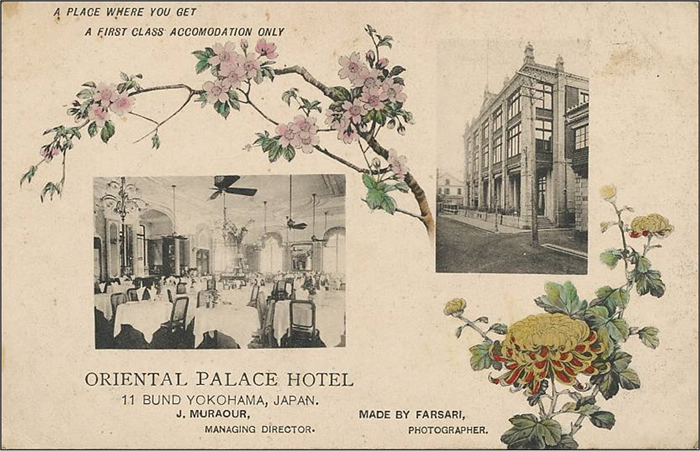ワイン会:2019/12/30
In 1859 after two centuries of seclusion policy, Yokohama opened its doors to foreign trade. Before this time Nagasaki was the only open port of Japan. Even then only a severely restricted number of five trading partners were established such as Holland and Quing, also known as China. However as Yokohama opened its doors and western culture flooded in and trading partners rose by eleven by 1869. Foreign nationals established settlements and legation offices. Chefs from foreign countries were invited. Books of western cuisine and food culture were published. Hotels were built and trading companies imported their own ingredients. Buddhist taboos on eating meat faded and many Japanese meat dishes were invented. Street foods like Yakitori, Croquette and Curry were sold. Sukiyaki restaurants and steak houses were established. Farmers started to grow western vegetables such as onions and peppers and a Japanese man who learnt how to bake on a French warship started a bakery in Yokohama. Other notable events include the establishement or many cafes and ice-cream stands.
In 1865, an authentic French restaurant was opened in Hotel des Colonies in Yokohama by Laplace Brothers who worked in Shanghai as French chefs. A French chef, Louis Beguex worked here who then went on to work as a head chef at the Grand Hotel Yokohama. He would then go on to establish the Oriental Hotel Kobe. Another French chef, Leon Muraour was invited to work in the French Legation Office who taught in Ueno Seiyo-ken as well.
In 1873 the Great Hotel Yokohama was opened, funded by several expats including Smith, a British public investor and Peard, a photographer. At the same time many of the patiserries opened in the foreigners settlement as many talented chefs worked there such as Carl Hess a swiss chef, who became head chef in Tukiji Seiyo-ken, and Polan Muraour who became the third head chef in the Grand Hotel Yokohama. Japanese chefs started to show their talent too. Kenkichi Watanabe worked in the Dutch legation office and became the 1st head chef at the Hall of Piers and then went on to open the Chuo-tei. Genkichi Fujita was also at the Chuo-tei and became head chef at the Rokumei - kan, the national guest house during the Meiji era and the centre of high society. In 1891 Leon Muraour laid the foundation of Orient Palace Hotel Yokohama where it became a fashionable destination.

In 1874 there were 382 foreign registered ships ported in Yokohama. In 1877, 167 foreign national trading companies were dominating Japanese trade with a share 97%. At that point 1,359 foreign settlers were living in Yokohama. Soon the first railway was inaugurated, the telecommunication system was laid and the coaches were stationed. The city was lit with gas lamps and it's fish market was opened. Water supplies ran from 1887, electrical grids were built in 1890 and thus Yokohama built up it's infrastructure as an international city.
Grand Hotel Yokohama had many talented chefs who went to have successful careers. Tamejiro Fukazawa worked for a French diplomat and British Legation Office and then established Toyo-ken. Kenkichi Yoshikawa became the first head chef in Imperial Hotel in Tokyo, Beijiro Takagi became the 7th head chef in Imperial Hotel succeeded by Bunjiro Ishiwatari. Also Sakutaro Kobayashi became the first head chef in Hotel New Otani in Tokyo.
Orient Palace Hotel Yokohama also had a lot of gifted chefs who, too, had a thriving later career. A. Dulon, a French chef who later became 3rd chief chef in Imperial Hotel. Katutaro Utumi became an assistant head chef for 4th head chef in Imperial Hotel. A. Projean who became head chef for Toyo-ken and first chief chef for Tokyo Kaikan. Toshio Suzuki became 5th head chef in Tukiji Seiyo-ken. Yusaku Arata who lived during the WWII when all the western terms were banned, lead western cooking in Japan and he worked for both Grand Hotel Yokohama and Orient Palace Hotel Yokohama.

You would presume to find authentic western cuisine mostly in places like Seiyo-ken and Imperial Hotel in Tokyo. But looking through the history and careers of these excellent chefs in Japan, you would find that Yokohama had been the epicentre. Louis Beguex, Muraour brothers and Carl Hess made remarkable conbribution and service for conveying their cuisine.
According to the menues on 19th Aug 1897 and January 1903, in Grand Hotel Yokohama had not only authentic French dishes but also various traditional European dishes and the menues were typed in English with French words here and there. Lunches and dinners were only served in courses and it offered total of about fifty choices. One soup, one fish dish, thirteen choices of relish, five choices for entrée、six choices for vegetable dishes, three choices for roasted dishes (selection of cold meat for lunch), ten choices for dessert, five choices for cheese, then choice of tea or coffee. Urbain-Dubois who succeeded Marie-Antoine Carême and compiled French cuisine in 19th century was instructing the course meal in Russia in same period. It is a supprise that the course meal was offered in Yokohama in same period.
For soup of the day, they offered traditional French style ones. As well as those dishes, they had American style clam chowder or chicken gambo, Scottish style mutton broth. They also invented their own soup which they used pasta or tapioca as toppings for extra texture.
For fish dishes, they offered British style deep fried fish or American style oyster cocktail.
For relish, they normally used Japanese style Tukudani.For relish, they normally used Japanese style Tukudani.
Entrée meant "the homemade dish inbetween" in those days, not as a main course as in today's term. Many of them were the pasta dishes or the rice dishes like Italian style risotto, ravioli or spagetti and Turkish style pilaf. Curry and rice seems to be the popular dish and chicken ,lamb, veal, chicken liver, prawn and oyster was used daily.
They also offered British pies, Irish stew, Spanish style beef stomach casserole (callos), American style devilled big feet and tortoise stew. Something like Welsh rarebit, Hamberger, Croquette, Beef stew were also served.
For the main dishes, they offered British style and served cold meat for lunches and roast dinner for evenings. Various meat were offered like beef, pork, chicken, turkey as well as games, livers and kidneys.
For desserts, the Scottish puddings were regularly served.
In Grand Hotel Yokohama, they served the European regional cuisine and we can imagine how rapidly the western culture flooded into the foreigner's settlement in Yokohama. They cleverly used the available local ingredients and mixed with western cuisine and created Yokohama's own unique foods. These technique were passed on to the Japanese talented chefs and there, the Japanese style western cuisine was accomplished. In the time of modernisation, these cuisine were spread all over Japan.
On the other hand, in Oriental Palace Hotel Yokohama were offering the authentic French cuisine. They used the sea bream or the trout for fish dishes which were locally available. For the meat dishes, they even offered Ris de veau, Moelle, Common Snipe, Bresse Chicken or Turkey. They also offered the latest dishes of the time. Peach Melba which was invented by Auguste Escoffier, the chef of Savoy Hotel in London and Beef fillet Rossini style were already there. It's been said that Masukichi Nishio, who studied in Ritz and became head chef in Tukiji Seiyo-ken, had introduced Escoffier's recipes but Yokohama had it before then. On 4th August 1899, when Ansei Treaties were signed, a state banquet was held in Oriental Hotel Yokohama, former name for Oriental Palace Hotel Yokohama. The menu on the night was equivalent to Ritz Paris or Savoy Hotel London, and we can see the talent of Mulaour Brothers there.
From these menues, we can see now that exquisite tastes were imported from western countries like truffles, foie gras, meats, chesses and hams. Wines were imported from Château Margaux, Château Mouton Rothschild and Château du Clos Vougeot. And more than twenty kinds of champagne were imported. They also had wines from California, Rhine, Chianti and Tokaji (Hungary), and as for the liquer, cognac and wisky, they offered as good selection as today's bars.
In 1923, Yokohama was devastated by the Great Kanto Earthquake and 1927 Hotel New Grand Yokohama was newly established. The head chef was Sally Weil who was a Swiss and working in Paris at that time. And for his assistant Katutaro Utumi and Yusaku Arata who were working in Imperial Hotel were selected. Eager and talented chefs gathered to work with them - like Shigetada Irie, Masataka Yamamoto, Seizo Tomura, Takeo Kizawa, Shokichi Ono, Hisashi Baba and Takio Mizuguchi - and the hotel was called the tigers den of western cuisine. Weil introduced À la carte style and from his kitchen Doria, Spagetti Napolitan and Pudding à la mode was created.
Yusaku Arata was born in 1895 and he compiled "Arata Western Cuisine" after the WWII. The book has over 100 rice recipes, over 200 flour based recipes including pizza and pasta, also some timbale recipes. Also threre were many liver and kidney recipes before the war in the menues of Grand Hotel Yokohama. We can see how the western cuisine became Yokohama's own creation.
So many changes and inventions were made and Yokohama's creations were accepted as new tastes all over Japan. Jean Anthelme Brillat-Savarin said, "The discovery of a new dish confers more happiness on humanity than the discovery of a new star." , he also said, "The numbers of tastes are countless." Today new tastes are born in all over the world. In Paris, New York and Yokohama.
Nobuya Kawachi, Chef of L'atelier 1959
ワイン会:2016/12/02
1859年、横浜が開港された。欧州各国の西洋文化は長崎経由でオランダと中国から間接的に流入してはいたが、今度は直接5カ国分、しかも鎖国中の200年間分、新旧問わず同時に入って来た。貿易国は1869年までにはさらに11カ国増えたことで、16カ国の食文化が一挙に津波の様に押し寄せて来た。居留地には各国の公使館が建てられ自国から料理人が呼び寄せられ、これまで知られなかった料理や飲食風俗を伝える料理書が次々に刊行された。外国商社は自国の食料品を持込み、次々にホテルができた。本格的な肉食文化の到来はこれまで禁忌を解き放ち、直ちに和食文化と融合し、串焼き、コロッケ、カレーなどの屋台や、牛鍋屋、ビフテキ屋が生まれた。西洋野菜の栽培が本格的に始まった。フランス軍艦でパンの作り方を学んだ日本人がパン屋を開業し、カフェやアイスクリーム・サロンができた。
横浜の本格的なレストランを併設したオテル・ド・コロニーは、上海租界で成功し新天地横浜にやってきたフランス料理人のラプラス兄弟(姓がLaplaceなのか、La Place(ラ・パレス)の兄弟なのかで大きく解釈が異なる。パレス・ホテル・シャンハイを売り払って横浜に進出した可能性もある。仮説調査中)らにより1865年に開業されたと言われる。このホテルでは幕臣小栗忠順が主導して建設された築地ホテル館料理長に抜擢され、さらにグランド・ホテル・ヨコハマの初代料理長、後にオリエンタル・ホテル・神戸を創業する、ラプラス兄弟の甥のフランス料理人ルイ・ベギューが腕を振るっていた。もうひとりの横浜居留地を代表するフランス料理人レオン・ミュラウール(おそらくニース郊外のグラースで香水で財を成し、オテル・ミュラウールも経営していたミュラウール一族。後にシャネルの5番の開発元。ベギューにしても、ミュラウールにしても料理人が、短期間でそれなりの規模のホテルを買収したり経営できたりすることは考えにくい。仮説調査中)は、この頃フランス公使館の料理人として来日し、上野精養軒の料理指導役としても活躍した。
グランド・ホテル・ヨコハマは1873年、横浜の公共事業に尽くしたイギリス人スミス、写真家ベアドら数名が資金を出し合い設立し、ルイ・ベギューが最初の西洋料理の礎を築いた。そしてこの頃、横浜居留地の洋菓子店では後に築地精養軒の初代料理長として招かれるスイス料理人カール・ヘスや、グランド・ホテル・ヨコハマの第3代料理長となるポーラン・ミュラウール、オランダ公使館では華族会館の初代料理長となり後に中央亭を創業する渡辺鎌吉、鹿鳴館の初代料理長となる藤田源吉らが才能を開花させていた。さらに1891年にはレオン・ミュラウールが"横浜の華"と呼ばれるオリエンタル・パレス・ホテル・ヨコハマを開業し、横浜の西洋料理を更に発展させた。

明治になってまもなくの横浜は、1974年の外国船籍入港数は382隻。1877年の欧米商社167社、在横欧米人1,359人、輸出入品取扱高の実に全国比97%となり賑わう。駅馬車や電信、鉄道が開通。高島嘉右衛門はガス灯を灯し、魚鳥獣青物市場を開設した。水道供給は1887年から、電力供給は1890年からと、国際都市としてのインフラが整ってゆく時代であった。
グランド・ホテル・ヨコハマからはフランス外交官のお抱え料理人からイギリス公使館を経て東陽軒を創業する深沢為次郎、帝国ホテル初代料理長に就任する吉川兼吉、帝国ホテル第7代料理長の高木米次郎、帝国ホテル第8代料理長の石渡文治郎、ホテル・ニューオータニ初代料理長の小林作太郎らを輩出した。
オリエンタル・パレス・ホテル・ヨコハマからは、帝国ホテル第3代料理長のフランス料理人A.デュロン、帝国ホテル第4代料理長の後ホテル・ニューグランド・ヨコハマの初代料理長として招かれたサリー・ワイルの補佐役となる内海藤太郎、東陽軒さらに東京會舘初代料理長のA.プロジャン、築地精養軒第5代料理長の鈴木敏雄らを輩出している。また戦前から戦後と日本の西洋料理界を牽引した荒田勇作は、グランド・ホテル・ヨコハマとオリエンタル・パレス・ホテル・ヨコハマの両方に在籍していた。

一流の西洋料理というと精養軒や帝国ホテルなど東京発祥という情報が多いが、横浜居留地で活躍した料理人を様々な方面で辿ると、日本における西洋料理の様々な源流となる溌剌とした横浜の姿が想像できる。彼らはこれまで言われていたような船員上がりのコックではなく、料理人としてそもそも一流の腕を持ちながらも、不安定な国内情勢から新天地を求め特権階級に随行して横浜の地を踏んだヴェンチャーであったのではなかろうか。横浜居留地を拠点に、精養軒や帝国ホテル、オリエンタル・ホテル・神戸などでも活躍し、多くの料理人を育て日本全国に送り出した、ルイ・ベギュー、レオンとボーランのミュラウール兄弟、カール・ヘスの功績は計り知れない。
1897年8月19日と1903年1月1日から31日までのグランド・ホテル・ヨコハマのレストラン・メニューにはフランス語混じりの英語で、現代のフランス料理には見られない何々風といった料理名や、各国の地方特有の料理がタイピングされている。夕食、及び昼食ともにコースのみで総品目は各50種類前後。スープ1種類、魚料理1種類、レリッシュ約13種類、アントレ約5種類、野菜料理約6種類、ロースト約3種類(昼食では冷製肉料理約6種類)、デザート約10種類、チーズ約5種類、それにコーヒーかお茶が付いて総品目は50種類前後が記され、上から順番に選べる構成になっている。アントナン・カレームの後を継いで19世紀のフランス料理を集大成したユルバン・デュボワが、コース構成のロシア式サービスをフランスで広め始めたこの頃、既に横浜においてもコース料理が提供されていたことには驚く。
メニューには、当時のフランス料理の基本的なものの他に、クラム・チャウダーやチキン・ガンボといったアメリカの南北を代表する料理、マトン・ブロスなどのスコットランド名物料理、あるいは浮き身にパスタやタピオカを浮かべた創作料理が見受けられる。また魚料理には、ロンドン名物のフライド・フィッシュやアメリカのオイスター・カクテルなどがある。さらにレリッシュには佃煮が定番として記されている。
アントレは今日の前菜という意味ではなく、文字通りの"間の手料理"として使われている。パスタ料理や米料理が多く、リゾット、ラビオリ、スパゲティーなどのイタリア料理、トルコ料理のピラフなどとバラエティーに富んでいる。特に鶏、羊、仔牛、鶏キモ、海老、牡蠣などを使ったカレーライスが日替わりで提供されていることから、人気メニューだったことが伺われる。
他には様々なイギリスのパイ料理。煮込料理にはアイリッシュ・シチュー、スペインのカジョスから創作されたと思われるスペイン風牛胃の煮込、アメリカ南部のソウルフードになるデビルド・ピッグフィート、スニークなところではスッポン・シチューがある。またウェールズを代表するパン料理のウェルシュ・レアビット、日本の家庭料理となったハンバーグ、様々なコロッケ、ビーフ・シチューなども記されている。
コースのメインは、夕食はロースト、昼食は冷製肉料理で典型的なイギリス式であった。食材には鶏、豚、牛の他に、ジビエや内蔵が多く使われている。またアメリカの七面鳥も記されている。デザートはスコットランド名物のプディングが定番として記されている。
グランド・ホテル・ヨコハマでは、欧米各国の郷土料理が提供されており、当時の横浜居留地には、欧米各国、情報の新旧問わず同時に、かつ急激に西洋文化が流入した。横浜開港時には、フランス革命後のレストラン早生期から黄金期にかけての革新と郷土料理への回帰ブームを背景とした特権階級である各国領事のお抱え料理人らの知見、さらにおそらくブリア=サヴァランまたはそれ以前から始まって、カレーム、デュボワ、ショファール、グーフェらの文献などに記されたフランス食文化や、イギリス、アメリカ、イタリアなどその他各国独自の食文化も一緒くたに流入したと考えるともの凄い情報量だったであろう。丁度ディグレレやファーヴルがパリのレストランで活躍していた時期と重なる。またグランド・ホテル・ヨコハマが創業した頃は、イギリスを除き欧米列強各国の国内平定の月日も浅いことから、それら国々に併合された都市国家の郷土文化を体現した料理が活き活きと輝いている様にも見て取れる。横浜の地を踏んだ料理人は横浜で手に入る食材を巧みに使いこなし、彼らキャリアと欧米各国の地方食文化を複雑に組み合わせ、横浜特有の創作料理が生み出していったのではないだろうか。そしてこれらの西洋創作料理が、横浜居留地に集まった日本人料理人に委ねられると同時に居留地外に散らばり、和洋折衷化された横浜創作料理が完成されていったと考えられる(西洋割烹と記される文献もある)。これらの横浜創作料理は一般的に洋食と呼ばれるようになり、近代化の後押しの中、日本全国に広がっていった。エスコフィエの登場はまだ先のことである。
一方、1903年レオン・ミュラウールが立ち上げたオリエンタル・パレス・ホテル・ヨコハマは、本格的なフランス料理を提供していた。魚料理には鯛や川マスなど、横浜で手に入る食材で工夫されている。肉料理にはリ・ド・ヴォーやモワル、田シギ、ブレス鶏、七面鳥なども記されている。驚くべき事にオーギュスト・エスコフィエが考案したピーチ・メルバや、牛フィレ肉のロッシーニ風を提供している。この頃の横浜には当時の最新のフランス料理情報や調理技術があったと考えられる。これまでエスコフィエの料理を日本で提供したのは、リッツで修行した築地精養軒第4代料理長の西尾益吉であると言われていた。また遡ってオリエンタル・パレス・ホテル・ヨコハマの前身となる1891年開業のオリエンタル・ホテル・ヨコハマでは、1899年8月4日に行われた「安政5カ国条約改正の祝典晩餐会」の記録が横浜開港資料館に残っている。この晩餐会の料理は、パリのオテル・リッツやロンドンのサヴォイ・ホテルと同じレベルの料理構成になっており、ミュラウール兄弟の力量が知れる。
これらレストラン・メニューから、高級食料品の輸入もさかんに行われていたことがわかる。トリュフ、フォアグラ、肉類、各国のチーズやハムなど様々にのぼる。瓶詰技術、缶詰技術、冷蔵冷凍技術は1800年代初頭にはヨーロッパで発明されていた。ワインはシャトー・マルゴー、シャトー・ムートン・ロートシルト、クロ・ウージョなど。シャンパーニュは実に20種以上。他のワインはカリフォルニア、ライン、キャンティ、トカイなど。リキュール、コニャック、ウィスキーなどの品揃えは今日のレストランと変わらない。
1927年、関東大震災で失なった横浜文化を再建しようとする動きが起こりホテル・ニュー・グランド・ヨコハマが創設された。初代料理長はパリからスイス料理人サリー・ワイルを招き、補佐役に横浜の西洋料理界に深く関わった内海藤太郎、荒田勇作らを帝国ホテルから横浜に呼び戻した。厨房には、入江茂忠、山本政孝、戸村誠蔵、木沢武男、小野正吉、馬場久、水口多喜男らの腕に覚えのある料理人らが集結し、西洋料理の虎の穴と呼ばれた。ワイルは、グランド・ホテル・ヨコハマでコース料理として提供していた欧米各国の郷土料理に最新のフランス料理技法を加え、日本で初めてアラカルト・スタイルで提供した。またこの厨房からドリア、ナポリタン、プリン・ア・ラ・モードが生まれたと言われる。
太平洋戦争後の横浜は小さなアメリカだった。横浜の接収面積は、国内接収面積の62%にのぼり、市街地の返還は1961年まで待たねばなかった。通りや施設にはアメリカ名がつけられ、焼け残った建物は進駐軍クラブやシアター、PXになった。アメリカ料理が提供され、アメリカと同じ本物のジャズやブルースが流れていた。日本全体の社会体制が大きく作り直され、横浜では進駐軍の仕事を得ることはステータスとなっていた。そして接収が徐徐に解除されるにつれ庶民的な洋食屋やバーが沢山できていった。
1895年に横浜で生まれ、戦前戦後と活躍した荒田勇作が集大成した「荒田西洋料理」には、100種類以上の米料理、200種類以上のパスタやピザを含む粉料理、米やパスタを工夫したタンバル料理が記されている。また戦前のグランド・ホテル・ヨコハマのレストラン・メニューに見られる、各国の郷土料理、内蔵やジビエを使った料理も多い。横浜に流入した各国の料理が、どのようにして横浜創作料理となり、洋食としてアレンジされていったのか読み取れる。
開港以来、横浜は諸外国の文化と日本が交わる巨大なハブであった。横浜創作料理は、様々な人の手によって工夫され、姿を変えながら、新しい味わいとして受け入れられていった。その特徴は、各国の郷土料理を組み合わせる。手に入る新鮮な食材で工夫する。米やパスタで創作する。内蔵を上手く活かす。ジビエ料理などがある。「新しい星を発見するよりも、新しい料理を発見するほうが人間を幸せにする」そして「味わいの数は果てしない」。アンテルム・ブリア=サヴァランである。昨今の日本の料理人の活躍には目を見張る物がある。新しい料理は、今日も、明日も、世界中の街で生まれ続ける。パリでも、ニューヨークでも、そして横浜でも。
2015年10月5日(2017年5月11日改訂)
文責 ラトリエ1959 料理人 河内 暢也
ワイン会:2015/11/18
さあ、今年もやってきました。
11月19日から、なくなり次第終了の期間限定。
ご利用料金は、男性4,800円。女性4,300円。
今年のボージョレ地区は気候にも恵まれ、
果実味が凝縮し、バランスのとれたしっかりとした味わい。
ご友人と、お仲間と、この時期だけの秋の新酒を楽しみませんか。
尚、お食事でご来店のお客様にも
ボージョレ・ヌーヴォー乾杯グラスワインをプレゼント致します。
ワイン会:2015/11/11
2015, Domaine de la Madone, Beaujolais Villages Nouveau, Rouge
ドメーヌ・ド・ラ・マドンヌ、ボージョレ・ヴィラージュ・ヌーヴォー、赤
昨年2014ヴィンテージは 「ワインスペクテーター」のヌーヴォー部門において、数あるヌーヴォーの中で最高点に輝きました。
世界的に高い評価を得ている自然派の造り手、ブルーノ・ベレール。 ワンランク上のボージョレ ヴィラージュです。
豊かで、しっかりとして完璧なバランス、 ボジョレにとり、とても偉大なヴィンテージ !
今年、厳しい暑さと歴史的な日照量のために、ボジョレのぶどう畑は、完璧に近い衛生状態を保つことができた。
ぶどうは、特に8月にわずかに雨が降ったおかげで、素晴らしい条件の中で成熟を終えた。 生産者はこのため、よく熟して小粒で、素晴らしい品質を備え、厚くしっかりとした果皮を持つぶどうを収穫した。
フェノール類の成熟は完璧で、糖度は自然に上昇した。生産者の記憶によると、ボジョレでこのように熟したことは見たことがないという。
しかし、収穫されたぶどうは爽やかさを保っていた。アルコール発酵を終えた最初のキュヴェには、熟した果実、しかし火を入れたようなニュアンスは全くない果実のアロマが感じられる。
口に含むと、2015年の豊かさがはじける。丸みがありたっぷりとしているが、バランスを全く失っていない。 ワインは桁外れに豊かで、豊満で、堅固なタンニンのストラクチュアが、長熟の年であることを予期させる。タンニンはきちんと存在しているが、絹のようにしなやかで、偉大な繊細さを帯びている。 ワインは濃く、深みのある色合いを見せている。2015年は、2002年以来、最も色が濃くなる可能性を見せている。
色と特にストラクチュアの面で、2015年は2009年や、最も古くは1947年を想起させる。いずれも素晴らしいヴィンテージで、明白な熟成能力を持っていた。
2015年の唯一の懸念事項は、数量である。厳しい暑さと、特に2015年上半期の乾燥のために、収穫量は少ない。2015年の収穫量は、600,000 hl近くと見られている(2014年は約756,000 hlであった)。
ワインは、酸、果実味、タンニンのバランスが完璧。2015年のボジョレは、偉大なヴィンテージとするためのすべての要素が揃っている。
ワイン会:2015/11/04



